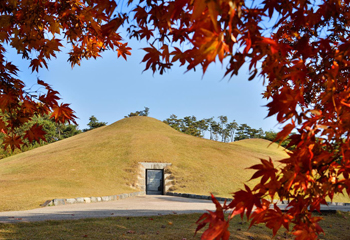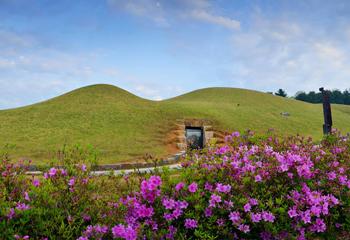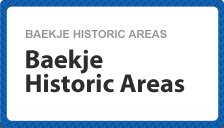Tomb of King Muryeong and Royal Tombs, Gongju
The Tomb of King Muryeong and Royal Tombs, Gongju are widely known as the Royal Tombs of Baekje or the Tomb of King Muryeong. They are located on the upper southeast ridgeline of a small hill (75m high), standing in the south of the Geumgang River and extending to a southeast direction.
The first excavation of the Tomb of King Muryeong and Royal Tombs, Gongju was conducted in 1927 and excavations were undertaken in 1932 illegally during the Japanese colonial period. The Tomb of King Muryeong was accidentally discovered during water drainage work on the Tomb of King Muryeong and Royal Tombs, Gongju in 1971, leading to full-fledged archaeological excavation.

The types of Baekje tombs discovered include the “stone chamber tomb with a corridor” and the “brick chamber tomb.” Tombs No.1 to No.5 are stone chamber tombs with a corridor and domed ceiling, which are the traditional type of Baekje tombs. Tomb No. 6 and the Tomb of King Muryeong are brick chamber tombs with a vaulted ceiling - a type of tomb that was popular in China during that period. These tombs were built after 475, the year of the capital’s relocation to Ungjin. The fact that all the tombs except for two were stone chamber tombs with a corridor suggests that the style and structure of a stone chamber tomb was well organized and established as an exclusive type of tomb for the royal family of Baekje during the Ungjin Period.
General Status of the Tomb of King Muryeong and Royal Tombs, Gongju
| ID No. | Types of Ceilings | Materials | Size of Burial Chamber | Shapes of Plane Surface | Floor | Others |
|---|---|---|---|---|---|---|
| No. 1 | Dome | Trimmed stones | 258×177×- | Rectangle | Pebbles | Plastering |
| No. 2 | Dome | Trimmed stones | 333×279×312 | Rectangle | Pebbles and stone slabs | Plastering |
| No. 3 | Dome | Trimmed stones | 337×275×200 | Rectangle | Pebbles and stone slabs | Plastering |
| No. 4 | Dome | Trimmed stones | 345×350×280 | Square | Pebbles and stone slabs | Plastering |
| No. 5 | Dome | Trimmed stones and bricks | 345×326×311 | Square | Brick coffin platform | Plastering |
| No. 6 | Vault | Bricks | 370×224×313 | Rectangle | Brick coffin platform | Murals |
| Tomb of King Muryeong | Vault | Bricks | 420×272×293 | Rectangle | Brick coffin platform | Lamp niches |
During the Ungjin Period, these standardized stone chamber tombs with a corridor rapidly had spread within the border areas of Baekje, constructed for tombs of the local ruling class from the 6th century. The Baekje kingdom’s tombs had spread out nationwide.
This type of tomb had certain structural weaknesses that made it easy to loot; many burial ob

The structure of the stone chamber tombs with corridor found in Songsan-ri consists of an entrance corridor, a wooden coffin, and a main burial chamber in which funerary ob
The size of the interior of these tombs may vary slightly, but the length of the entrance corridor accounts for about two meters, while the height and width are about one meter. The main burial chamber is three meters in length and width, and has a square floor. The ceiling is domed, with walls rising vertically up to a certain height before narrowing toward the center from that point, which is covered by a large stone slab on the top.
The two brick chamber tombs in Songsan-ri - Tomb No. 6 and the Tomb of King Muryeong - have arched ceilings, rectangular burial chambers, and peach-shaped lamp niches installed in the east, west, and north walls.
Tomb No. 6 contains murals of the Four Deities. It was the only case that such figures have been found in a brick chamber tomb. After plastering mud or mortar on the spots in the four sides where the murals were to be drawn, the murals were painted with whitewash; the figures of sun and moon were also painted on the south wall.
The Tomb of King Muryeong had never been disturbed by grave robbery. It is the rare case among all the ancient royal tombs of East Asia for which the identity of its occupant has been confirmed and has found intact. Therefore, the Tomb of King Muryeong plays a central role in research on East Asian royal tombs. The discovery of the buried tomb stone has revealed that King Muryeong and his queen were buried inside the tomb, and the exact dates of their deaths and burial have been explicitly confirmed as well. The Tomb of King Muryeong constitutes a tomb in determining the construction period of historic sites and findings as well as in estimating the status of the buried person for research on ancient tombs in China, Korea, and Japan.
The archaeological findings excavated from the tomb clearly attest to the international exchange with other regions of Asia at the time of King Muryeong. The coffin made of Japanese wood and the tomb guardian beasts and pottery from China were found inside the tomb, illustrating international exchanges with other regions of East Asia. Also, there were glass beads made of lead originated from Thailand. Flower ornaments for the diadem of the queen are the same patterns with the railings of the Great Stupa in India. These archaeological findings indicate that Baekje engaged in international exchanges with other regions of Asia.










